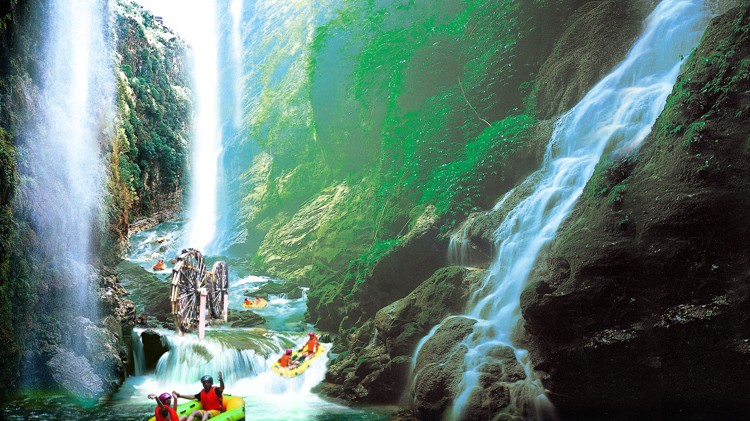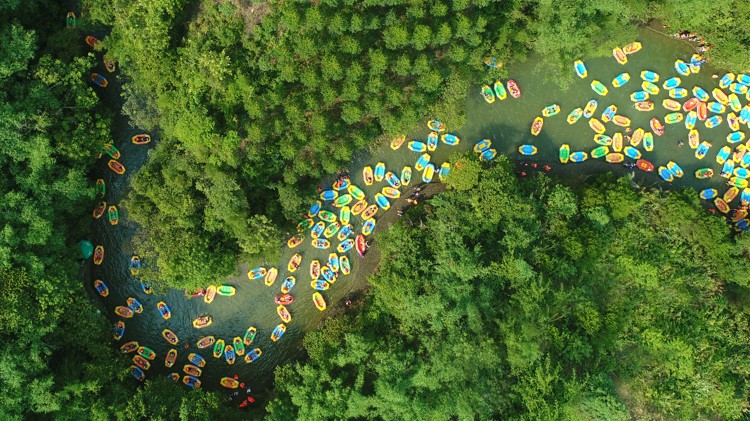Drifting is a mass water activity, especially in summer, where many people go rafting and are welcomed by many. So, let's take a look at the basic knowledge and precautions of rafting together.

Generally speaking, rafting can be divided into three categories: adventure rafting, natural rafting, and controlled rafting. In a sense, the first two categories can also be classified as natural rafting, but the difference is that adventure rafting does not emphasize public participation and focuses on exploration, so it is more dangerous. In a narrow sense, natural rafting and controlled rafting are more of a mass water sports and entertainment activity, and what we usually refer to as rafting is this type of rafting.
Drifting activities have been widely carried out internationally, and some countries have reached a widespread level. In China, due to the improvement of the living environment and quality of life of the masses in recent years, rafting activities have also begun to transform into popular mass sports activities.
Drifting activities are different from other outdoor tourism activities. They have strict organizational discipline and safety measures to ensure, and their selection of drifting tools and drifting channels is also strict and scientific.
Basic knowledge of drifting
The drifting period is from April to October each year. Before departure, it is advisable to choose simple and easy to dry clothes, but not too thin or too light in color, otherwise you will feel embarrassed if you fall into the water. In addition, bring a set of clean clothes for replacement when disembarking, and a pair of plastic slippers for wearing on board; When participating in rafting in low temperature weather, you can bring your own raincoat or purchase a raincoat at the starting point of rafting; Friends with glasses, please tie them with rubber bands.
When drifting, cash and valuable items are not allowed to be carried on board. In case of capsizing or other accidents, the drifting company and insurance company will not compensate tourists for the lost cash and items; If you feel that the opportunity is rare and you must bring a camera, it is best to bring a low value foolproof machine. Wrap it in a plastic bag in advance, open it when flat, and wrap it when crossing dangerous rapids, and be prepared to throw it into the water;
The first thing to do on board is to carefully read the drifting instructions, follow the arrangements of the boatman, wear life jackets, and find safety ropes; When a drifting boat passes through a dangerous beach, it should follow the instructions of the boatman, not move around casually, grasp the safety rope tightly, tighten its feet, and tilt its body towards the center of the ship; If a ship capsizes, you don't need to panic at all, you need to remain calm because you are wearing a life jacket; It is not allowed to get off the ship and swim casually. Even if swimming, one should follow the advice of the boatman and swim on a calm water surface. It is not allowed to move independently away from the ship's hull.
The float boat is made of polymer materials and has three independent air compartments. Under normal use, there will be no air leakage problem. Due to the shallow water of the stream, even if there is a problem, it can be promptly ashore, sound the distress whistle on the life jacket, search for rescue personnel, and replace the float boat.
Safe crossing of dangerous shoals.
During the drifting process, please pay attention to the arrows and slogans along the way. They can help you find the main waterway and be alert to falling water areas in advance. Before reaching the dangerous beach, you can first predict the approximate direction of going downstream; Then call everyone to retract their oars, put their feet back into the boat and gather them together. Grasp the safety rope on the edge of the boat with both hands, lower your body, do not stand up, stabilize the center of gravity of the boat, and generally, you can cross safely.
Rush out of the vortex.
When the water flow in a river is deep, vortices often appear. At this time, it is advisable to avoid being drawn in and passing by as much as possible. If you are caught up in it, keep calm and let the boat rotate along the flow. When it turns to the periphery of the vortex, everyone can paddle with all their strength to get out of the predicament.
Avoid collisions.
Maintaining stability and avoiding collisions are principles that must be followed during the drifting process. When there is absolutely no way to avoid it, the boat body should be controlled at a frontal collision angle (side collisions can easily cause capsizing), and personnel should grip the rope tightly. After a collision, the hull of the boat will be parallel to the shore. At this time, passengers on this side should pay attention to retracting their feet to avoid being pinched. Sometimes boats come very close to each other, and to avoid collision, both sides need to cooperate and paddle in the opposite direction or push against the hull.
Stranding.
In areas with dense stones, waterways become narrower, water depth becomes shallower, and water flow becomes faster, making it easy for stranding to occur. At this point, there is no need to panic. You can use an oar to hold the stone and use force to lift the boat away from the grounding point. If this move is not effective, send personnel to go into the water, pull or push the boat from the side, and the person pulling the boat should be quick witted and pay attention to safety.
Falling into the water.
If you accidentally fall into the water, don't panic. The buoyancy of the life jacket is enough to lift people to the surface of the water, and the companions on the boat should extend paddles for the drowning person to grasp. If the person who falls into the water is far away from the rubber boat, they should find a way to get ashore or stay on the back surface of the stone (the water flow on the upstream surface is strong and easy to be hit by the rubber boat) and wait for rescue.
Capsize.
Capsizing often occurs in areas with turbulent water flow, often due to unstable center of gravity caused by someone falling into the water. After capsizing, one should remain calm and first straighten the hull of the boat; When re boarding the boat, pay attention to balancing the forces on both sides, and have someone press down on the other side when personnel climb onto the boat. The fallen paddles should be picked up in a timely manner, otherwise they will have to be paddled by hand in the slow flow area. Chamber rupture is the worst-case scenario. To adjust the position of personnel on the boat, do not sit in the position of the ruptured air chamber; Try to keep the rubber boat stable and dock for rescue.

Selection of Drifting Rivers
(1) Control Drifting
Drifting is the process of effectively controlling the drifting process by the boatman who controls the drifting boat. The drifting participants complete the entire process under the control of the boatman. Strictly speaking, drifters are just passengers on the drifting boat, and they complete the drifting process according to the control of the boatman during the drifting process. Drifting is generally carried out in high mountain valleys with fast, deep, and complex terrain. Currently, the tourism drifting activities developed by Bailonggong Tourism Co., Ltd. are typical of drifting. Drifting is both thrilling and safe, making it a popular form of drifting among tourists.
(2) Natural drift
Natural drifting is generally carried out in shallow and gentle river channels. Natural rafting is about allowing every tourist to freely participate in rafting activities. The rafting organizers only provide necessary rafting boats, rafts, paddles, and other equipment, and supervise and protect them at various key points along the way, allowing tourists to drift the entire process on their own. This form of rafting is smooth and lacks stimulation, but it is a good choice for middle-aged and elderly rafting enthusiasts.

Selection of Drifting Equipment
The so-called drifting equipment refers to boats, boats, rafts and other drifting items floating on the water, as well as life jackets and other life saving items worn by drifters.
The drifting boat used in the Panjiang drifting activity is the safest rubber boat. The drifter sits in the boat and is operated by the boatman. There is a rubber boat, and the drifter sits in the boat and is operated by the boatman. A rubber boat floats and surges on the bottom of the waves and valleys, with endless risks and joy. The life safety of the drifter is protected by both equipment and manual labor.
Notes for Drifters
(1) Panjiang rafting is an outdoor water sports tourism activity, and patients with severe heart disease, mental illness, hypertension, high myopia and other diseases are not suitable to participate in such activities;
(2) The organization and arrangement of participants in the entire drifting process by the organizers or boatmen;
(3) Drifters are not allowed to leave the boat and launch without permission during the drifting process;
(4) If a boat capsizes and falls into the water, there is no need for the drifter to panic. The life jacket absolutely ensures your safety. Actively cooperate with the boatman's rescue measures for rescue, and board the boat again to continue drifting;
(5) Drifters should unite, be friendly, and help each other throughout the entire drifting activity, and drift the entire journey in a tense, stimulating, joyful, and safe environment.
